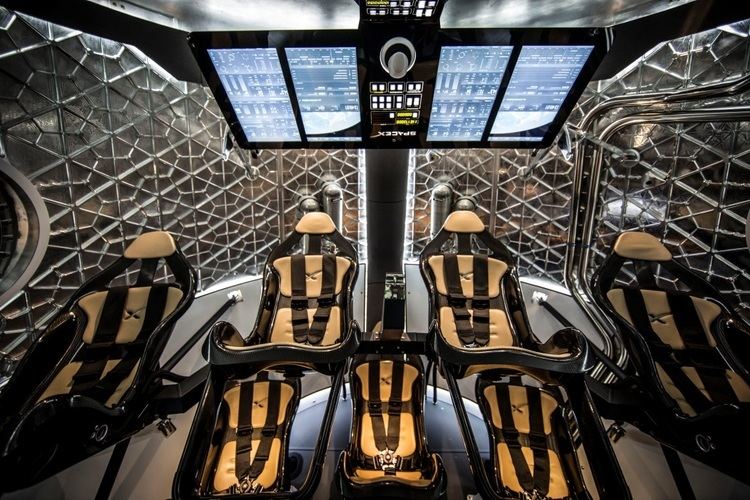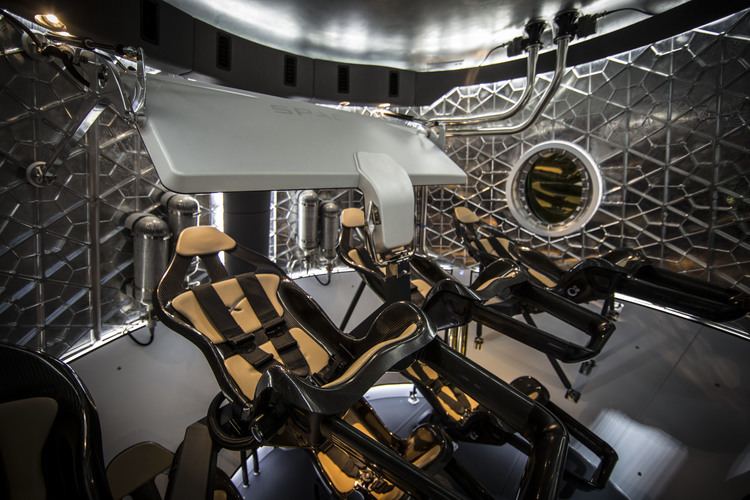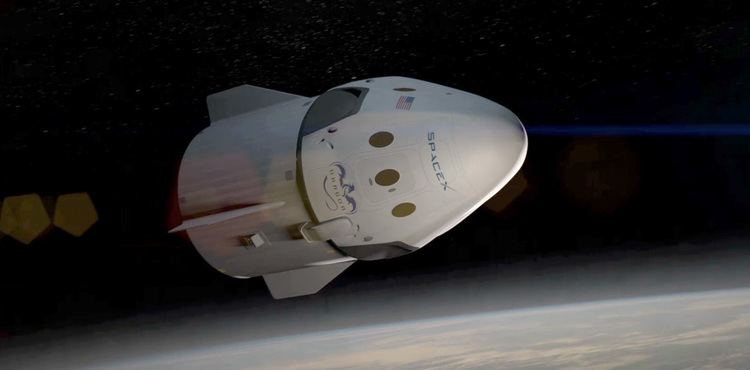Crew 7 (max. capacity) Manufacturer SpaceX | Sidewall angle 15 degrees | |
 | ||
Role Placing humans and cargo into Low Earth orbit (commercial use)
and ISS commercial taxi CCtCap (government use), space colonization (planned) Launch vehicle Falcon 9 (into orbit)
Falcon Heavy (to the Moon) Height 8.1 metres (27 ft) with trunk Diameter 3.7 metres (12 ft) with trunk Similar SpaceX Dragon, Red Dragon, CST‑100 Starliner, JCSAT‑2B, Amos‑6 | ||
Dragon 2 propulsive hover test
Dragon 2 (also Crew Dragon, Dragon V2, or formerly DragonRider) is the second version of the SpaceX Dragon spacecraft, which will be a human-rated vehicle able to make a terrestrial soft landing. It includes a set of four side-mounted thruster pods with two SuperDraco engines each, which can serve as a launch escape system (or launch abort system (LAS)) or be used for propulsive landings. Also, it has much larger windows, landing legs which extend from the bottom of the spacecraft, new flight computers and avionics, and redesigned solar arrays, all packaged in a spacecraft with a changed outer mold line from the initial cargo Dragon that has been flying for several years.
Contents
- Dragon 2 propulsive hover test
- Dragon 2 development history
- Technical specifications
- Planned space transport missions
- Crewed Circumlunar Flight
- Flight testing
- Pad abort test
- Hovering test
- Uncrewed orbital test flight
- In flight abort test
- Crewed orbital test flight
- References

The spacecraft was unveiled on May 29, 2014 during a press event at SpaceX headquarters in Hawthorne, California. Designed to ferry astronauts to space, the capsule differs considerably from the cargo-carrying Dragon, which has been operational since 2010. Dragon 2 is scheduled to make an unmanned first orbital flight in November 2017, and to carry its first astronaut crew in May 2018. SpaceX completed a launch pad abort test of the spacecraft on 6 May 2015 and a hovering test on 24 November 2015.

NASA has signed a contract to procure up to six crewed flights to the International Space Station under the Commercial Crew Development.

Dragon 2 development history

The crewed variant of Dragon was initially called DragonRider. It was intended from the beginning to support a crew of seven or a combination of crew and cargo. It was planned to be able to perform fully autonomous rendezvous and docking with manual override ability; and was designed to use the NASA Docking System (NDS) to dock to the ISS. For typical missions, DragonRider would remain docked to the ISS for a period of 180 days, but would be designed to be able to do so for 210 days, the same as the Russian Soyuz spacecraft. From the earliest design concepts which were publicly released in 2010, SpaceX planned to use an integrated pusher launch escape system for the Dragon spacecraft, claiming several advantages over the tractor detachable tower approach used on most prior crewed spacecraft. These advantages include the provision for crew escape all the way to orbit, reusability of the escape system, improved crew safety due to eliminating a stage separation, and the ability to use the escape engines during landings for a precise solid earth landing of the capsule. An emergency parachute system will be retained as both a redundant backup and for water landings.

As of 2011, the Paragon Space Development Corporation was assisting in developing DragonRider's life support system. In 2012, SpaceX was in talks with Orbital Outfitters about developing space suits to wear during launch and re-entry.

At a NASA news conference on 18 May 2012, SpaceX confirmed again that their target launch price for crewed Dragon flights is $160,000,000, or $20,000,000 per seat if the maximum crew of 7 is aboard, and if NASA orders at least four DragonRider flights per year. This contrasts with the 2014 Soyuz launch price of $76,000,000 per seat for NASA astronauts.
In October 2014, NASA selected the Dragon spacecraft as one of the candidates to fly American astronauts to the International Space Station under the Commercial Crew Program. SpaceX plans to use the Falcon 9 launch vehicle for launching Dragon 2.
SpaceX intends to certify their propulsive landing scheme, in parallel with the parachute-to-water-landing method for Dragon 2, with the goal to hold to the development schedule and "ensure U.S. crew transportation safely and reliably in 2017. Land landing will become the baseline for the early post-certification missions" while precision water landing under parachutes was proposed to NASA as "the baseline return and recovery approach for the first few flights of Crew Dragon."
Following the successful test of the launchpad abort system in May 2015, Elon Musk indicated that the Dragon capsule platform, launched on a Falcon Heavy launch vehicle, could be used to transport robotic space probes across much of the solar system, including Earth's Moon, Mars, or Jupiter's moon Europa. Musk indicated that Dragon could transport 2 to 4 tonnes (4,400 to 8,800 lb) of useful payload to the surface of Mars.
Technical specifications
Dragon 2 includes the following features:
The landing system is being designed to accommodate three types of landing scenarios:
The parachute system was fully redesigned from the one used in the prior Dragon capsule, due to the need to deploy the parachutes under a variety of launch abort scenarios.
Planned space transport missions
Dragon has been designed to fulfill a set of mission requirements that will make the capsule useful to both commercial and government customers. SpaceX and Bigelow Aerospace are working together to support round-trip transport of commercial passengers to low Earth orbit (LEO) destinations such as the planned Bigelow Commercial Space Station. In that use, the full passenger capacity of seven passengers is planned to be used.
SpaceX competed for a contract with NASA to deliver some number of specific crew-transport missions to the ISS under the third phase of the Commercial Crew Development program.
In an August 2014 presentation, SpaceX revealed that if NASA chooses to use the Dragon 2 space capsule under a Commercial Crew Transportation Capability (CCtCap, Commercial Crew Development) contract, then only four of the seven possible seats would be used for carrying NASA-designated passengers to the ISS, as NASA would like to use the added payload mass and volume ability to carry pressurized cargo. Also, all NASA landings of Dragon 2 are planned to initially use the propulsive deceleration ability of the Super Draco engines only for a propulsive assist right before final touchdown, and would otherwise use parachutes "all the way down."
On September 16, 2014, NASA announced that SpaceX, together with Boeing, has been selected to provide crew transport ability to ISS. SpaceX will receive $2.6 billion under this contract. NASA considers Dragon to be the cheapest proposal.
In a departure from prior NASA practice during the first five decades of the space age, where NASA contracted with commercial firms to build spaceflight equipment and then NASA operated the spacecraft directly, NASA is purchasing space transport services from SpaceX with the Dragon 2 contract, and will leave the launch, transit, and operation of the spacecraft to SpaceX.
According to Elon Musk in a question and answer session at the May 29, 2014 unveiling of the Dragon 2, the older version of Dragon will be used in tandem with Dragon 2 as a cargo ferry for coming years.
Following the Dragon 2 pad abort test in early May 2015, Musk revealed plans to use variant of the Dragon 2 spacecraft—in conjunction with the Falcon Heavy launch vehicle—to transport science cargos across much of the solar system, in cislunar and inner solar system regions such as Mars in 2018 but also to outer solar system destinations such as Jupiter's moon Europa. Details include that SpaceX expects to be able to transport 2,000–4,000 kg (4,400–8,800 lb) to the surface of Mars, including a soft retropropulsive landing using SuperDraco thrusters following a limited atmospheric deceleration. For destinations with no atmosphere, the Dragon variant would omit the parachute and heat shield, and add propellant.
Crewed Circumlunar Flight
On February 27, 2017, SpaceX CEO Elon Musk announced that the company will attempt to fly two private citizens on a free return trajectory around the moon in late 2018. The Dragon 2 spacecraft would launch on the Falcon Heavy booster. The two private citizens, who have not yet been named, approached SpaceX about taking a trip around the moon, and have "already paid a significant deposit" for the cost of the mission, according to a statement from the company. The names of the two individuals will be announced later, pending the result of initial health tests to ensure their fitness for the mission, the statement said. The two passengers would be the only people on board what SpaceX expects to be about a week-long trip around the moon, according to Musk, who spoke with reporters during a phone conference. "This would be a long loop around the moon. . .It would skim the surface of the moon, go quite a bit further out into deep space and then loop back to Earth," Musk said during the teleconference. "So I'm guessing, distance-wise, maybe [about 500,000 to 650,000 kilometers]. The Dragon spacecraft would operate, in large part, autonomously, but the passengers would have to train for emergency procedures. The Dragon 2 capsule will require some upgrades for the deep-space flight, but Musk said those would be limited mainly to installing a long-range communications system.
Flight testing
SpaceX is planning a program of four tests for the Dragon 2 that will include both a "pad abort" test, and an in-flight abort test, plus both an uncrewed robotic orbital flight to the ISS, and finally a 14-day crewed demonstration mission to the ISS in 2018.
Pad abort test
In August 2014, it was announced that the pad abort test would occur in Florida, at SpaceX's leased pad at SLC 40. While a flight-like Dragon 2 and trunk were used for the pad abort test, they rested atop a truss structure for the test rather than a full Falcon 9 rocket. A crash test dummy embedded with a suite of sensors was placed inside the test vehicle to record acceleration loads and forces at the crew seat, while the remaining six seats were loaded with weights to simulate full-passenger-load weight. The test objective was to demonstrate sufficient total impulse, thrust and controllability to conduct a safe pad abort.
The pad abort test was conducted successfully on 6 May 2015 at approximately 0900 Eastern Daylight Time (EDT). The vehicle splashed down safely in the ocean to the east of the launchpad 99 seconds later. A fuel mixture ratio issue was detected after the flight in one of the eight SuperDraco engines, but did not materially affect the flight. More detailed test results were to be subsequently analyzed by both SpaceX and NASA engineers.
Hovering test
On November 24, 2015, SpaceX conducted a test of Dragon 2's hovering abilities at the firm’s rocket development facility in McGregor, Texas. In a video published by the firm, the spacecraft is shown suspended to a hoisting cable and igniting its SuperDraco engines. The capsule hovers in equilibrium for about 5 seconds, kept in balance by its 8 engines firing at reduced thrust to compensate exactly for gravity.
This video shows the second test of the two-part milestone under NASA’s Commercial Crew Development program. The first test, a short firing of the engines intended to verify a healthy propulsion system, was completed two days earlier on November 22.
Uncrewed orbital test flight
The first orbital test of Dragon 2 will be an uncrewed mission, designated SpX-DM1 and scheduled for November 2017. The spacecraft will test the approach and automated docking procedures with the ISS, remain docked for a few weeks, then conduct the full re-entry, splashdown and recovery steps to qualify for a crewed mission. Life support systems will be monitored all along the test flight. The same capsule will be later re-used for an in-flight abort test.
In-flight abort test
SpaceX plans to conduct an in-flight abort test from Kennedy Space Center Launch Complex 39A in Florida after the first uncrewed orbital test flight and prior to the first crewed test flight. The test will be conducted with the refurbished capsule from the uncrewed test flight. Earlier, this test had been scheduled before the uncrewed orbital test, however SpaceX and NASA consider it safer to use the more recently designed capsule rather than the older test article from the pad abort test.
The Dragon 2 test capsule will be launched in a sub-orbital flight to conduct a separation and abort scenario in the troposphere at transonic velocities, at Max Q, where the vehicle experiences maximum aerodynamic pressure. The test objective is to demonstrate the ability to safely move away from the ascending rocket under the most challenging atmospheric conditions of the flight trajectory, imposing the worst structural stress of a real flight on the rocket and spacecraft. The capsule will then splash down in the ocean with traditional parachutes, possibly with assistance of its integrated thrusters to smooth the final moments of the descent.
The in-flight abort capsule was originally planned to launch on F9R Dev2 before the Falcon 9 Full Thrust vehicle (and its densified propellants) made F9R Dev2 incompatible with both of SpaceX's active orbital launch pads. Then a special version of the Falcon 9 first stage with just three engines was prepared for this test and carried to the launch pad at Vandenberg in April 2015 to conduct a tanking test. It was erected on the revised and rebuilt transporter erector (TE) and fully loaded with propellants on 9 April 2015 to test both the vehicle and ground support equipment. Those plans were later scrapped, and as of August 2016 it is not known which vehicle SpaceX will use for the in-flight abort test.
Crewed orbital test flight
Dragon 2 is scheduled to carry its first crew, of two NASA astronauts, on a 14-day test flight mission to the ISS in May 2018. If this schedule is followed they may be the first people to ride an American spacecraft into orbit since the last Shuttle flight in 2011, as Boeing's CST-100 Starliner is currently slated to fly its first astronauts in August 2018. NASA has named its first Commercial Crew astronaut cadre of four veteran astronauts to work with SpaceX and Boeing - Robert Behnken, Eric Boe, Sunita Williams, and Douglas Hurley. The SpX-DM2 mission will complete the last milestone of the Commercial Crew Development program, paving the way to starting commercial services under an upcoming ISS Crew Transportation Services contract.
